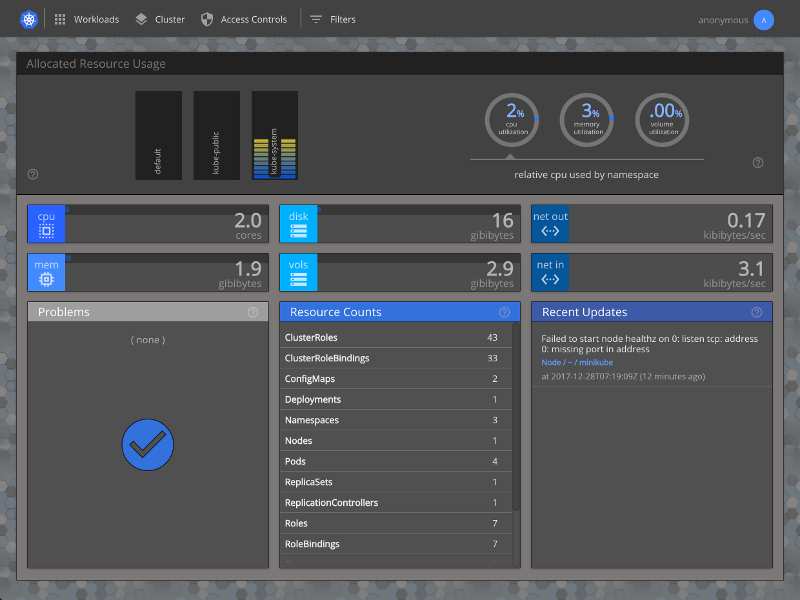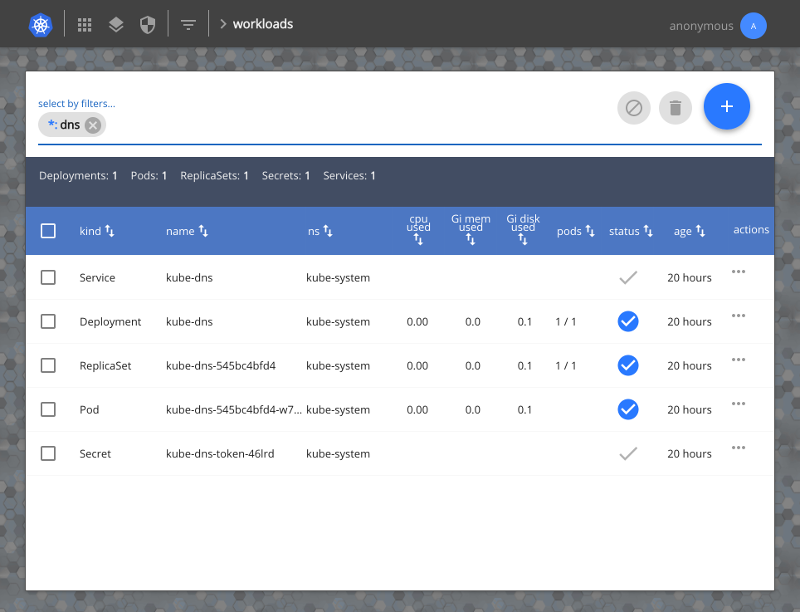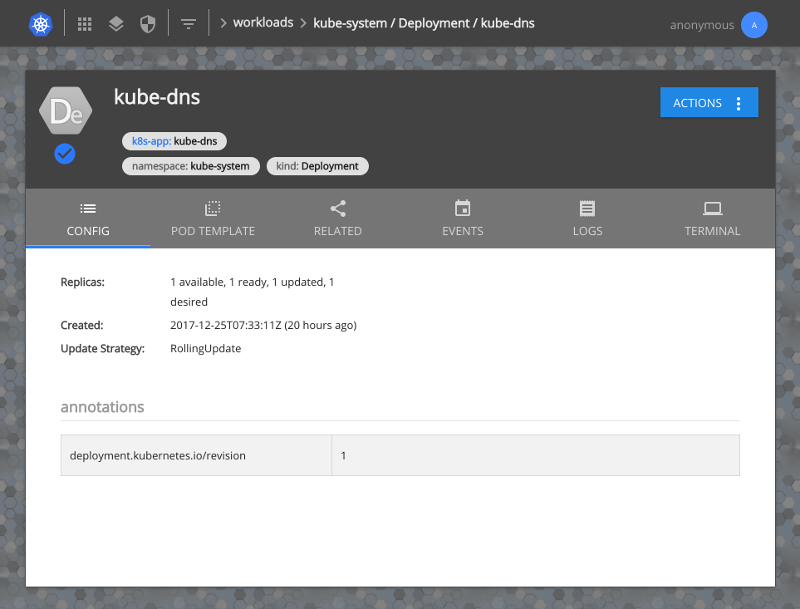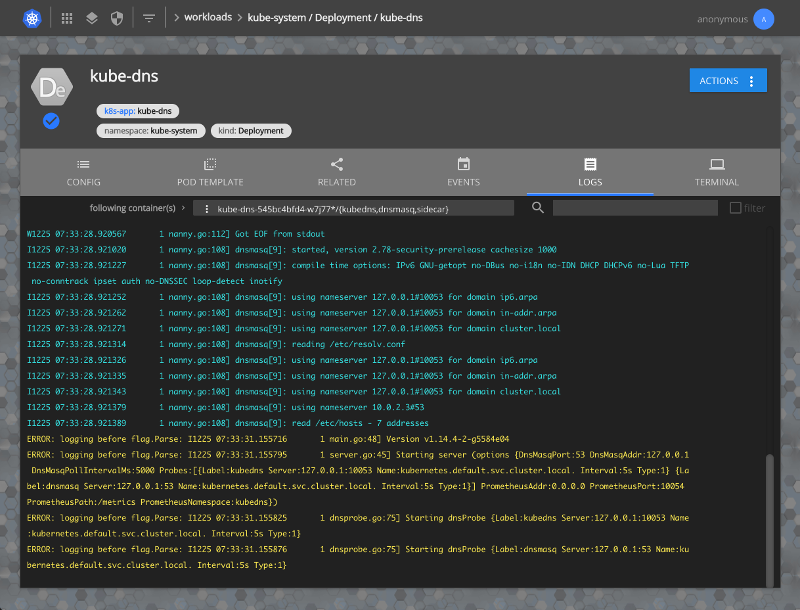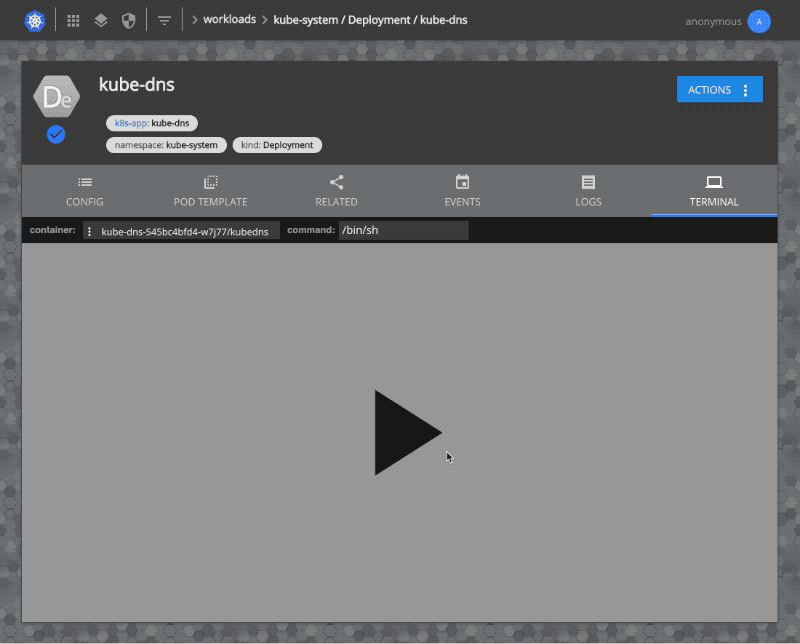(pronounced "kwill")
A multitenant UI for kubernetes.
Goal
To provide a multi-tennant* UI for Kubernetes capable of integrating with popular enterprise authentication mechanisms, and that helps the casual user come up to speed quickly on the components that make up their applications.
Why create another dashboard?
The key differentiators when compared with the existing open source dashboard are built-in support for enterprise SSO integrations like SAML 2 and OpenID+Connect, combined with the proxying of all requests as the logged-in user (via user-impersonation). See this discussion for details surrounding the trade-offs involved in running the existing dashboard in a multi-tenant environment.
What does it look like?
Login
Overview with Summaries for Errors, Events, and Resource Usage
Filtered Workloads view
Resource
Related resources view
Multi-container Log Tailing
Interactive Terminal
Test Drive
Getting Started On minikube
Prerequisites:
minikubedocker
-
Start a new
minikubecluster with RBAC enabled (if you don't already have one)minikube start --extra-config apiserver.Authorization.Mode=RBAC
-
Deploy
kuillcurl -sL https://raw.githubusercontent.com/matt-deboer/kuill/master/hack/deploy/kuill-dependencies.yml | \ kubectl --context minikube apply -f - curl -sL https://raw.githubusercontent.com/matt-deboer/kuill/master/hack/deploy/kuill-minikube.yml | \ kubectl --context minikube apply -f -
-
View it in your browser
open "http://$(minikube ip):30443/"
Installation
Start with the example deployment manifest in hack/deploy/kuill-example-deployment.yml:
-
If you deploy it as-is, you'll be able to log in as user
anonymouswith groupssystem:authenticated. -
Optionally, you can configure an identity/authentication mechanism:
- OpenID+Connect:
--public-url value The public-facing URL for this app, used to compose callbacks for IDPs [$KUILL_PUBLIC_URL] --oidc-provider value The OIDC provider base URL [$KUILL_OIDC_PROVIDER] --oidc-provider-description value The OIDC provider display name [$KUILL_OIDC_PROVIDER_DESCRIPTION] --oidc-provider-name value The OIDC provider short name (identifier) [$KUILL_OIDC_PROVIDER_NAME] --oidc-user-claim value The OIDC claim that should be passed as the user's ID in kube API proxy calls (default: "email") [$KUILL_OIDC_USER_CLAIM] --oidc-groups-claim value The OIDC claim that should be passed as the user's groups in kube API proxy calls (default: "groups") [$KUILL_OIDC_GROUPS_CLAIM] --oidc-additional-scopes value A comma-separated list of additional OAuth2 scopes ('openidconnect' is already included) to request (default: "email,profile") [$KUILL_OIDC_ADDITIONAL_SCOPES] --oidc-client-id value The OAuth2 client ID [$KUILL_OIDC_CLIENT_ID] --oidc-client-secret value The OAuth2 client secret [$KUILL_OIDC_CLIENT_SECRET] --oidc-nonce value The OIDC nonce value to use (default: "a3VpbGx2MC4xLWEzLTEyLWdkNDUzOTkzK2xvY2FsX2NoYW5nZXNkNDUzOTkzMzgyYTZjNGY1ZWY2NThjZTBlZDg2ZmFhNTBlYzc3ZjNh") [$KUILL_OIDC_NONCE] --oidc-credentials-in-query Whether to pass client-id and client-secret as query parameters when communicating with the provider [$KUILL_OIDC_CREDENTIALS_IN_QUERY]- SAML2:
--public-url value The public-facing URL for this app, used to compose callbacks for IDPs [$KUILL_PUBLIC_URL] --saml-idp-metadata-url value The metadata URL for a SAML identity provider [$KUILL_SAML_IDP_METADATA_URL] --saml-idp-shortname value The short name to use for the saml identity provider [$KUILL_SAML_IDP_SHORTNAME] --saml-idp-description value The description for the saml identity provider [$KUILL_SAML_IDP_DESCRIPTION] --saml-sp-cert value The certificate file to use for this service provider [$KUILL_SAML_SP_CERT] --saml-sp-key value The private key file to use for this service provider [$KUILL_SAML_SP_KEY] --saml-groups-attribute value The name of the attribute containing the user's groups [$KUILL_SAML_GROUPS_ATTRIBUTE] --saml-groups-delimiter value The delimiter that, if specified, will be used to split single group values into multiple groups [$KUILL_SAML_GROUPS_DELIMITER] --saml-audience value The audience that will be used to verify incoming assertions; defaults to using the metadata url of this service provider [$KUILL_SAML_AUDIENCE]- Password File (intended only for testing/demo purposes; see
hack/test-users.tsvfor example)
--password-file value A file containing tab-delimited set of [user,password,group...], one per line; for local testing only [$KUILL_PASSWORD_FILE]
Developing
Run make minidev locally to:
- Spin up (if not already started) a
minikubesetup similar to the test-drive script above. - Start a local HMR web dev environment
Code away--PRs welcome!
Roadmap:
1.0 Release (no date yet)
-
General:
- Create e2e tests for the most basic features
- Working minikube example deployment/guide
- Test on GKE deployments--can we even have an authenticating proxy configured?
- Come up with a better name ! (kuill)
- Support for Third Party Resources / Custom Resource Definitions
- Create/Edit validation for all resources
- Provide better hints/tool-tips to explain what functions are available, and what they mean
- Large scale performance testing (1000's of resources)
- Mobile testing/fixes/support
- Use Impersonation; replace authenticating-proxy
- Helm Chart for easy install
-
Overview/Homepage:
- Local storage (or cookies) used to remember previous selected namespaces for a given user
- Integrate resource quotas into cluster resource stats
- Handling for large numbers of namespaces
-
Workloads:
- Test authorization for edit/create/delete actions using kube apis before displaying/enabling the associated controls
- Provide utilization metrics with pods/deployments/etc., and corresponding summaries by selection
- Rollup ReplicaSets under Deployments as "versions"
- Rollup Jobs under CronJobs as "runs"
-
Cluster:
- Use tabs for PersistentVolumes, StorageClasses, TPRs(CustomResources)
-
Access Controls:
- Update styles to be consistent with Workloads/Cluster
- Add 'Can user X do action Y on resource Z?' button/check to aid with permissions checks
- Add 'What can user X do?' view which lists a summary of a given user's permissions




